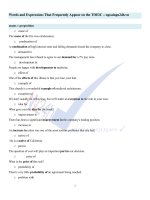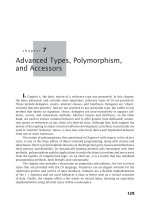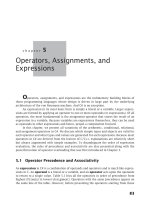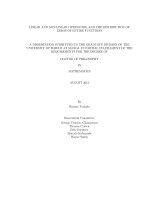Types, operators and expressions
Bạn đang xem bản rút gọn của tài liệu. Xem và tải ngay bản đầy đủ của tài liệu tại đây (354.72 KB, 15 trang )
35
Chapter 2 - Types, Operators and
Expressions
Variables and constants are the basic data objects manipulated in a program. Declarations list
the variables to be used, and state what type they have and perhaps what their initial values are.
Operators specify what is to be done to them. Expressions combine variables and constants to
produce new values. The type of an object determines the set of values it can have and what
operations can be performed on it. These building blocks are the topics of this chapter.
The ANSI standard has made many small changes and additions to basic types and expressions.
There are now signed and unsigned forms of all integer types, and notations for unsigned
constants and hexadecimal character constants. Floating-point operations may be done in
single precision; there is also a long double type for extended precision. String constants may
be concatenated at compile time. Enumerations have become part of the language, formalizing
a feature of long standing. Objects may be declared const, which prevents them from being
changed. The rules for automatic coercions among arithmetic types have been augmented to
handle the richer set of types.
2.1 Variable Names
Although we didn't say so in Chapter 1, there are some restrictions on the names of variables
and symbolic constants. Names are made up of letters and digits; the first character must be a
letter. The underscore ``_'' counts as a letter; it is sometimes useful for improving the
readability of long variable names. Don't begin variable names with underscore, however, since
library routines often use such names. Upper and lower case letters are distinct, so x and X are
two different names. Traditional C practice is to use lower case for variable names, and all
upper case for symbolic constants.
At least the first 31 characters of an internal name are significant. For function names and
external variables, the number may be less than 31, because external names may be used by
assemblers and loaders over which the language has no control. For external names, the
standard guarantees uniqueness only for 6 characters and a single case. Keywords like if,
else, int, float, etc., are reserved: you can't use them as variable names. They must be in
lower case.
It's wise to choose variable names that are related to the purpose of the variable, and that are
unlikely to get mixed up typographically. We tend to use short names for local variables,
especially loop indices, and longer names for external variables.
2.2 Data Types and Sizes
There are only a few basic data types in C:
char
a single byte, capable of holding one character in the local character set
int
an integer, typically reflecting the natural size of integers on the host machine
float
single-precision floating point
double
double-precision floating point
In addition, there are a number of qualifiers that can be applied to these basic types. short and
long apply to integers:
short int sh;
long int counter;
The word int can be omitted in such declarations, and typically it is.
36
The intent is that short and long should provide different lengths of integers where practical;
int will normally be the natural size for a particular machine. short is often 16 bits long, and
int either 16 or 32 bits. Each compiler is free to choose appropriate sizes for its own
hardware, subject only to the the restriction that shorts and ints are at least 16 bits, longs are
at least 32 bits, and short is no longer than int, which is no longer than long.
The qualifier signed or unsigned may be applied to char or any integer. unsigned numbers
are always positive or zero, and obey the laws of arithmetic modulo 2
n
, where n is the number
of bits in the type. So, for instance, if chars are 8 bits, unsigned char variables have values
between 0 and 255, while signed chars have values between -128 and 127 (in a two's
complement machine.) Whether plain chars are signed or unsigned is machine-dependent, but
printable characters are always positive.
The type long double specifies extended-precision floating point. As with integers, the sizes
of floating-point objects are implementation-defined; float, double and long double could
represent one, two or three distinct sizes.
The standard headers <limits.h> and <float.h> contain symbolic constants for all of these
sizes, along with other properties of the machine and compiler. These are discussed in
Appendix B.
Exercise 2-1. Write a program to determine the ranges of char, short, int, and long
variables, both signed and unsigned, by printing appropriate values from standard headers
and by direct computation. Harder if you compute them: determine the ranges of the various
floating-point types.
2.3 Constants
An integer constant like 1234 is an int. A long constant is written with a terminal l (ell) or L,
as in 123456789L; an integer constant too big to fit into an int will also be taken as a long.
Unsigned constants are written with a terminal u or U, and the suffix ul or UL indicates
unsigned long.
Floating-point constants contain a decimal point (123.4) or an exponent (1e-2) or both; their
type is double, unless suffixed. The suffixes f or F indicate a float constant; l or L indicate a
long double.
The value of an integer can be specified in octal or hexadecimal instead of decimal. A leading 0
(zero) on an integer constant means octal; a leading 0x or 0X means hexadecimal. For example,
decimal 31 can be written as 037 in octal and 0x1f or 0x1F in hex. Octal and hexadecimal
constants may also be followed by L to make them long and U to make them unsigned: 0XFUL
is an unsigned long constant with value 15 decimal.
A character constant is an integer, written as one character within single quotes, such as
'x'. The value of a character constant is the numeric value of the character in the machine's
character set. For example, in the ASCII character set the character constant '0' has the value
48, which is unrelated to the numeric value 0. If we write '0' instead of a numeric value like
48 that depends on the character set, the program is independent of the particular value and
easier to read. Character constants participate in numeric operations just as any other integers,
although they are most often used in comparisons with other characters.
Certain characters can be represented in character and string constants by escape sequences
like \n (newline); these sequences look like two characters, but represent only one. In addition,
an arbitrary byte-sized bit pattern can be specified by
'\ooo'
37
where ooo is one to three octal digits (0...7) or by
'\xhh'
where hh is one or more hexadecimal digits (0...9, a...f, A...F). So we might write
#define VTAB '\013' /* ASCII vertical tab */
#define BELL '\007' /* ASCII bell character */
or, in hexadecimal,
#define VTAB '\xb' /* ASCII vertical tab */
#define BELL '\x7' /* ASCII bell character */
The complete set of escape sequences is
\a alert (bell) character \\ backslash
\b backspace \? question mark
\f formfeed \' single quote
\n newline \" double quote
\r carriage return \ooo octal number
\t horizontal tab \xhh hexadecimal number
\v vertical tab
The character constant '\0' represents the character with value zero, the null character. '\0'
is often written instead of 0 to emphasize the character nature of some expression, but the
numeric value is just 0.
A constant expression is an expression that involves only constants. Such expressions may be
evaluated at during compilation rather than run-time, and accordingly may be used in any place
that a constant can occur, as in
#define MAXLINE 1000
char line[MAXLINE+1];
or
#define LEAP 1 /* in leap years */
int days[31+28+LEAP+31+30+31+30+31+31+30+31+30+31];
A string constant, or string literal, is a sequence of zero or more characters surrounded by
double quotes, as in
"I am a string"
or
"" /* the empty string */
The quotes are not part of the string, but serve only to delimit it. The same escape sequences
used in character constants apply in strings; \" represents the double-quote character. String
constants can be concatenated at compile time:
"hello, " "world"
is equivalent to
"hello, world"
This is useful for splitting up long strings across several source lines.
Technically, a string constant is an array of characters. The internal representation of a string
has a null character '\0' at the end, so the physical storage required is one more than the
number of characters written between the quotes. This representation means that there is no
limit to how long a string can be, but programs must scan a string completely to determine its
length. The standard library function strlen(s) returns the length of its character string
argument s, excluding the terminal '\0'. Here is our version:
38
/* strlen: return length of s */
int strlen(char s[])
{
int i;
while (s[i] != '\0')
++i;
return i;
}
strlen and other string functions are declared in the standard header <string.h>.
Be careful to distinguish between a character constant and a string that contains a single
character: 'x' is not the same as "x". The former is an integer, used to produce the numeric
value of the letter x in the machine's character set. The latter is an array of characters that
contains one character (the letter x) and a '\0'.
There is one other kind of constant, the enumeration constant. An enumeration is a list of
constant integer values, as in
enum boolean { NO, YES };
The first name in an enum has value 0, the next 1, and so on, unless explicit values are
specified. If not all values are specified, unspecified values continue the progression from the
last specified value, as the second of these examples:
enum escapes { BELL = '\a', BACKSPACE = '\b', TAB = '\t',
NEWLINE = '\n', VTAB = '\v', RETURN = '\r' };
enum months { JAN = 1, FEB, MAR, APR, MAY, JUN,
JUL, AUG, SEP, OCT, NOV, DEC };
/* FEB = 2, MAR = 3, etc. */
Names in different enumerations must be distinct. Values need not be distinct in the same
enumeration.
Enumerations provide a convenient way to associate constant values with names, an alternative
to #define with the advantage that the values can be generated for you. Although variables of
enum types may be declared, compilers need not check that what you store in such a variable is
a valid value for the enumeration. Nevertheless, enumeration variables offer the chance of
checking and so are often better than #defines. In addition, a debugger may be able to print
values of enumeration variables in their symbolic form.
2.4 Declarations
All variables must be declared before use, although certain declarations can be made implicitly
by content. A declaration specifies a type, and contains a list of one or more variables of that
type, as in
int lower, upper, step;
char c, line[1000];
Variables can be distributed among declarations in any fashion; the lists above could well be
written as
int lower;
int upper;
int step;
char c;
char line[1000];
The latter form takes more space, but is convenient for adding a comment to each declaration
for subsequent modifications.
39
A variable may also be initialized in its declaration. If the name is followed by an equals sign
and an expression, the expression serves as an initializer, as in
char esc = '\\';
int i = 0;
int limit = MAXLINE+1;
float eps = 1.0e-5;
If the variable in question is not automatic, the initialization is done once only, conceptionally
before the program starts executing, and the initializer must be a constant expression. An
explicitly initialized automatic variable is initialized each time the function or block it is in is
entered; the initializer may be any expression. External and static variables are initialized to
zero by default. Automatic variables for which is no explicit initializer have undefined (i.e.,
garbage) values.
The qualifier const can be applied to the declaration of any variable to specify that its value
will not be changed. For an array, the const qualifier says that the elements will not be altered.
const double e = 2.71828182845905;
const char msg[] = "warning: ";
The const declaration can also be used with array arguments, to indicate that the function
does not change that array:
int strlen(const char[]);
The result is implementation-defined if an attempt is made to change a const.
2.5 Arithmetic Operators
The binary arithmetic operators are +, -, *, /, and the modulus operator %. Integer division
truncates any fractional part. The expression
x % y
produces the remainder when x is divided by y, and thus is zero when y divides x exactly. For
example, a year is a leap year if it is divisible by 4 but not by 100, except that years divisible by
400 are leap years. Therefore
if ((year % 4 == 0 && year % 100 != 0) || year % 400 == 0)
printf("%d is a leap year\n", year);
else
printf("%d is not a leap year\n", year);
The % operator cannot be applied to a float or double. The direction of truncation for / and
the sign of the result for % are machine-dependent for negative operands, as is the action taken
on overflow or underflow.
The binary + and - operators have the same precedence, which is lower than the precedence of
*, / and %, which is in turn lower than unary + and -. Arithmetic operators associate left to
right.
Table 2.1 at the end of this chapter summarizes precedence and associativity for all operators.
2.6 Relational and Logical Operators
The relational operators are
> >= < <=
They all have the same precedence. Just below them in precedence are the equality operators:
== !=
Relational operators have lower precedence than arithmetic operators, so an expression like i
< lim-1 is taken as i < (lim-1), as would be expected.
40
More interesting are the logical operators && and ||. Expressions connected by && or || are
evaluated left to right, and evaluation stops as soon as the truth or falsehood of the result is
known. Most C programs rely on these properties. For example, here is a loop from the input
function getline that we wrote in Chapter 1:
for (i=0; i < lim-1 && (c=getchar()) != '\n' && c != EOF; ++i)
s[i] = c;
Before reading a new character it is necessary to check that there is room to store it in the
array s, so the test i < lim-1 must be made first. Moreover, if this test fails, we must not go
on and read another character.
Similarly, it would be unfortunate if c were tested against EOF before getchar is called;
therefore the call and assignment must occur before the character in c is tested.
The precedence of && is higher than that of ||, and both are lower than relational and equality
operators, so expressions like
i < lim-1 && (c=getchar()) != '\n' && c != EOF
need no extra parentheses. But since the precedence of != is higher than assignment,
parentheses are needed in
(c=getchar()) != '\n'
to achieve the desired result of assignment to c and then comparison with '\n'.
By definition, the numeric value of a relational or logical expression is 1 if the relation is true,
and 0 if the relation is false.
The unary negation operator ! converts a non-zero operand into 0, and a zero operand in 1. A
common use of ! is in constructions like
if (!valid)
rather than
if (valid == 0)
It's hard to generalize about which form is better. Constructions like !valid read nicely (``if
not valid''), but more complicated ones can be hard to understand.
Exercise 2-2. Write a loop equivalent to the for loop above without using && or ||.
2.7 Type Conversions
When an operator has operands of different types, they are converted to a common type
according to a small number of rules. In general, the only automatic conversions are those that
convert a ``narrower'' operand into a ``wider'' one without losing information, such as
converting an integer into floating point in an expression like f + i. Expressions that don't
make sense, like using a float as a subscript, are disallowed. Expressions that might lose
information, like assigning a longer integer type to a shorter, or a floating-point type to an
integer, may draw a warning, but they are not illegal.
A char is just a small integer, so chars may be freely used in arithmetic expressions. This
permits considerable flexibility in certain kinds of character transformations. One is exemplified
by this naive implementation of the function atoi, which converts a string of digits into its
numeric equivalent.
/* atoi: convert s to integer */
int atoi(char s[])
{
int i, n;









